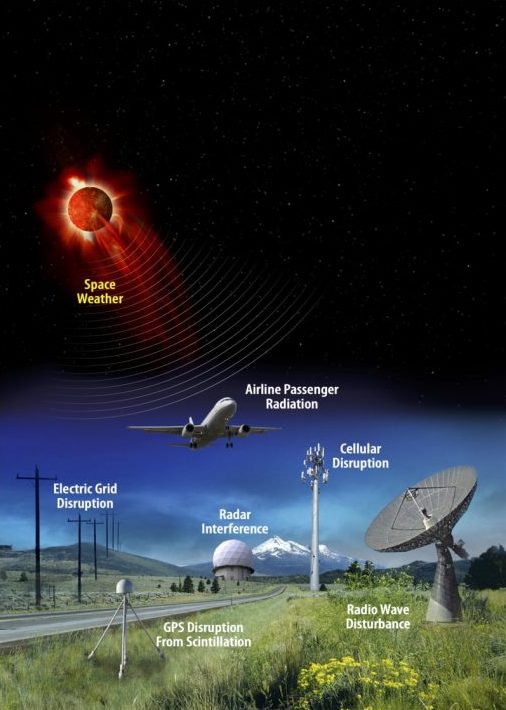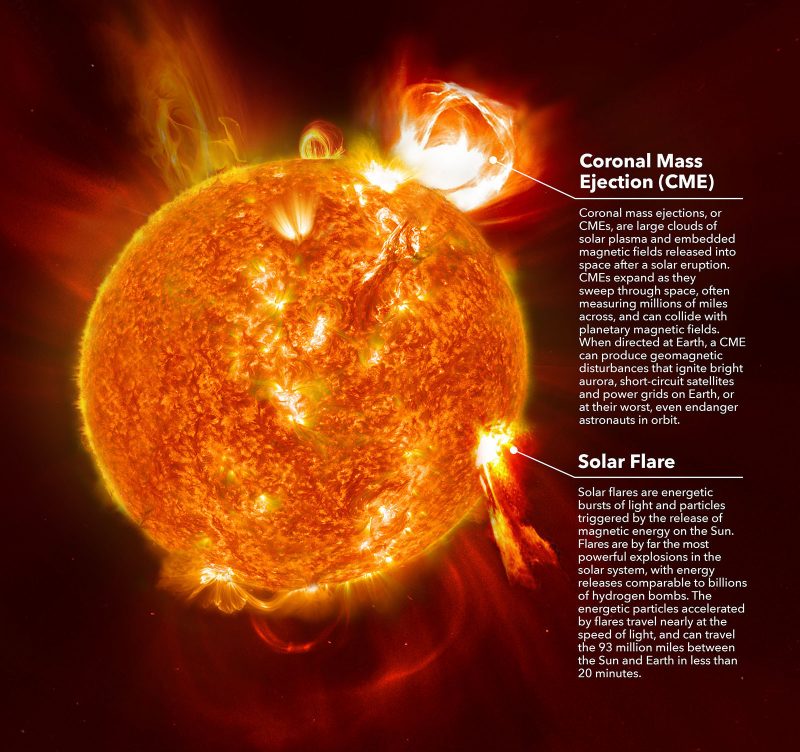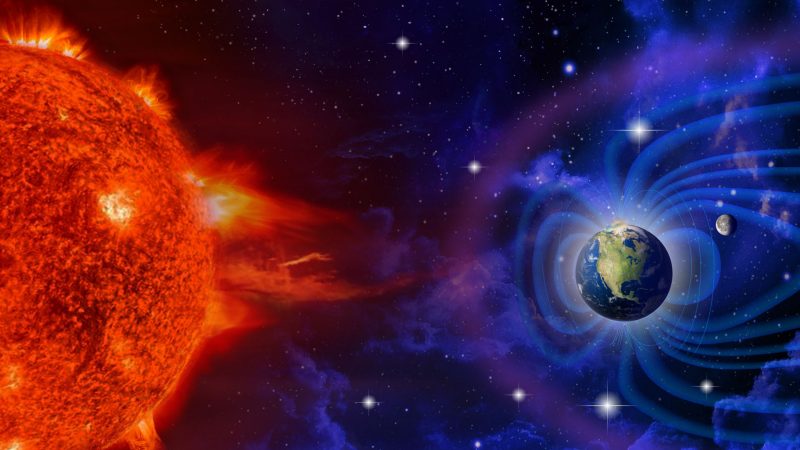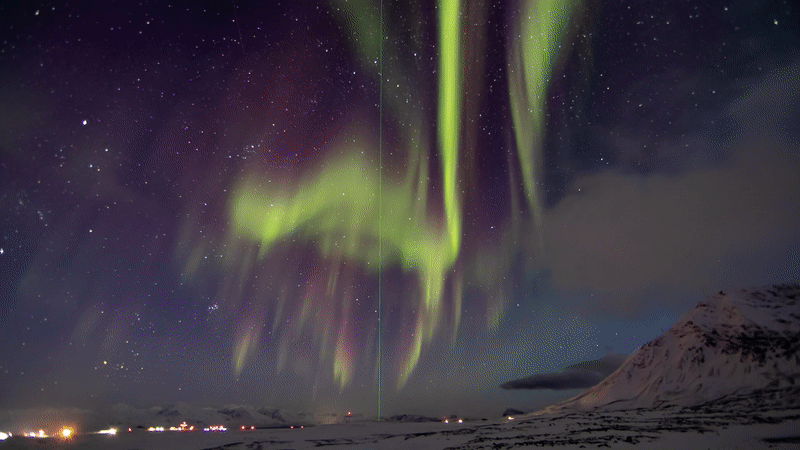
This post originally appeared on December 10, 2021, at NASA.gov by Alison Gold. Edits by EarthSky.
Solar Cycle 25 is well underway, and due to peak around the middle of this decade. In EarthSky’s daily sun activity update, you’ll find up-to-date information on solar activity and possible geomagnetic storms.
Checking the weather
Open the weather app on your phone or glance at the news and you can quickly find a detailed forecast for the weather in your location. The report is likely to affect your behavior for the day: if you put on sandals or snow boots, if you exercise indoors or jog around the block, if you walk to work or take the bus.
Similarly, space is full of dynamic weather patterns that can have real effects for life on Earth. Space weather refers to conditions in the solar system produced by the sun’s activity.
Just as weather is always occurring on Earth, space weather is ongoing. Even without major solar activity, satellites and communications systems can be impacted by variability in the density and composition of the near-earth environment.
Alexa Halford, space physics researcher at NASA’s Goddard Space Flight Center in Greenbelt, Maryland, said:
Space isn’t empty like we often think. The study of space weather is really just trying to understand the space environment around us, like we try to understand terrestrial weather.

Space weather and earthly technologies
At its most extreme, space weather can disrupt radio communications and endanger astronauts. In the past, activity on the sun has even temporarily caused large electrical blackouts.
But with forecasting and proper preparation, these disruptive effects can be largely avoided. That’s why NASA studies space weather conditions.
Also, there are several space weather sites to follow on Twitter to get up-to-date information, such as the one below.
And, below that, you’ll find the top 5 questions (and answers) about spaceweather.
A G3 (Strong) geomagnetic storm watch is now in effect for 11 May with a partial halo CME that erupted from the Sun on 9 May. https://t.co/TV7Yw6LXRw #spacewx pic.twitter.com/QKWNo77NKC
— NOAA Space Weather (@NWSSWPC) May 10, 2023
1. What kind of weather events occur in space, and when are they likely to strike?
Quite different from your average terrestrial rain or snow, space weather in our solar system is composed of radiation and particles from the sun.
The sun is made up of superhot electrically charged plasma, the fourth state of matter. Plasma constantly streams toward the planets as solar wind, pouring energy into near-Earth space.
However, that’s not all the sun is capable of doing. Sometimes, it hosts much more dramatic events. Solar flares are tremendous explosions on the surface of the sun, releasing energy which travels at the speed of light. Their effects on Earth are apparent in eight minutes. Coronal mass ejections (CMEs) are eruptions of large clouds of solar plasma and magnetic fields from the sun. The geomagnetic storms resulting from these events may occur one or several days later. CMEs and solar flares can also occur at the same time.
The sun operates in an 11-year solar cycle, and CMEs and flares are more common during the middle part of the solar cycle, called solar maximum.
Antti Pulkkinen, director of the Heliophysics Science Division at NASA Goddard, said:
During solar maximum, the sun may produce several CMEs per day and a few truly massive explosions per year.
In comparison, during solar minimum, the sun may be relatively quiet for extended periods of time. In solar cycle 25, the sun is expected to hit solar maximum around 2025.

2. Why doesn’t space weather just torch us?
Earth has a strong, large magnetic field produced by charged molten iron churning in its core. That field keeps away most of the charged solar wind streaming toward Earth, just like an umbrella works in a rainstorm. The area within the safety of Earth’s magnetic field is called the magnetosphere.
Earth’s magnetosphere is quite large and strong. On the side away from the sun, it extends hundreds of times the length of Earth’s roughly 4,000-mile (6,000-km) radius. The magnetosphere faces much more pressure on the side facing the sun, where it extends six to 10 times Earth’s radius (between around 25,000 miles to 40,000 miles or 40,000 km to 65,000 km).
Halford said:
The magnetosphere is this really nice protective shield. It blocks out most of the radiation and bad weather that you get in space, but not all of it.
Another barrier is Earth’s thick atmosphere, which blocks harmful light radiation from the sun from reaching Earth’s surface.

3. What are the effects of space weather on Earth?
As Halford explains, the protection offered by the magnetosphere isn’t perfect. There are three main ways that an explosion on the sun’s surface can affect Earth.
Radio blackout storm: This type of storm, generated by electromagnetic energy – light, mostly in wavelengths that are invisible to human eyes – is most likely to occur following a solar flare. It takes light only eight minutes to reach Earth from the sun, so the effects from this type of event are almost immediate. Electromagnetic energy released in flares disrupts Earth’s upper atmosphere – the region where communication signals travel – and can cause signal blackouts.
One risk of a radio blackout is that radios are often used for emergency communications, for instance, to direct people amid an earthquake or hurricane. Imagine that a solar storm happens to coincide with a natural disaster, when radio communications are essential for keeping people safe. This happened during the September 2017 Hurricane Irma. If operators are notified quickly, they can change radio frequencies and avoid an outage.
Solar radiation storm: A solar radiation storm emits a sea of very small, fast-moving charged particles. At their accelerated speed, these particles carry lots of energy and can permeate the magnetosphere and endanger astronauts and spacecraft in Earth’s orbit. To avoid the radiation impact, sensitive systems in satellites may be powered off and astronauts may be instructed to build shelter or move to better shielded sections within their spacecraft. Halford likens it to hiding in a basement during a tornado.
Geomagnetic storm: Within one to three days of a solar eruption, giant clouds of plasma, CMEs, may reach Earth’s orbit, compressing the magnetosphere. The influx of charged particles and electromagnetic fields rippling through Earth’s magnetosphere can induce currents in many important electrical systems on Earth’s surface, including power grids. Major blackouts from geomagnetic storms occurred in 1989 and 2003. Halford and Pulkkinen said in many countries, including the United States, there are safeguards in place to decrease the likelihood of this happening again.
4. How do scientists monitor space weather?
A variety of agencies keep close watch on space weather. And NOAA’s Space Weather Prediction Center is the U.S. government’s official source for space weather forecasts. NASA Heliophysics coordinates research efforts with NOAA, the National Science Foundation, the U.S. Geological Survey, and the U.S. Air Force Research Laboratory on the National Space Weather Strategy and Action Plan. NASA Heliophysics also maintains a fleet of scientific observatories to observe solar eruptions and Earth-directed space weather.
5. Can you prepare for space weather events?
Scientists and federal government organizations monitor and prepare for space weather events. Engineers work to build “rad-hard,” or radiation resistant, satellites. Astronauts may need to take shelter during certain space weather events. Power grid operators may implement safeguards against geomagnetic storm effects. The United States government maintains a webpage with information about what to do if space weather causes a power outage or other damage.
However, for most individuals, Halford says there’s only one thing they may wish to do in the event of a space weather event: prepare for the aurora. Those near the poles may get to see beautiful displays of light in the sky as the loss of particles from the magnetosphere during a geomagnetic storm excites particles in Earth’s atmosphere. Traveling to a location with a good view may require a flight, a hotel reservation, a hot chocolate and a warm blanket. During some strong geomagnetic storms, the aurora is visible further from the poles.

Bottom line: NASA answers questions about space weather, from what are its effects on Earth to how can we prepare.











